Phnom Penh’s most beautiful and striking feature is its long, lush riverside, but in the city center it’s mostly clogged up with wild traffic, “happy pizza” restaurants, and tuk-tuk drivers peddling vices. The Balé, a new 18-room luxury hotel located around 15 kilometers outside the city center, is the first property we’ve seen to take full advantage of the city’s riparian beauty, which explains why expats and wealthy Cambodians have been flocking here for “staycations” ever since it opened in early 2018.
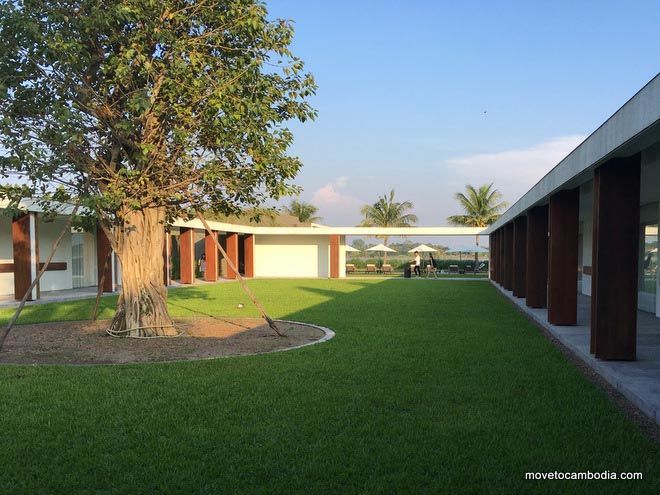
Banyon tree in the courtyard of The Balé (pronounced “Bah-LAY”) in Phnom Penh.
The hotel is located on the Chroy Changvar peninsula, part of a miles-long tangle of islands and sandbars that clog the Mekong and its sister river, the Tonle Sap, as they roll down to Phnom Penh. The peninsula has escaped the frenzied pace of development in Phnom Penh proper, because it has for years been connected to the mainland only by a single bridge donated by the Japanese government. This is changing, though, with the construction of new bridges (one is smack next to the Japanese bridge but paid for by China, which is now competing madly with Japan to purchase influence in Southeast Asia through gifts of infrastructure).
Well-connected local businesspeople have been jockeying to buy up swaths of Chroy Changvar for massive “satellite cities,” the price of land is skyrocketing, and all sorts of amenities are springing up that would have been unthinkable five years ago, from sushi bars to luxury condominiums. Still, until now most of the accommodation on the peninsula has been mid-range or budget hotels, aimed squarely at the local market. The Balé is a symptom of the new wave of development here, even as it takes full advantage of its early-adopter status by positioning itself as an oasis of calm amid the frenzy.
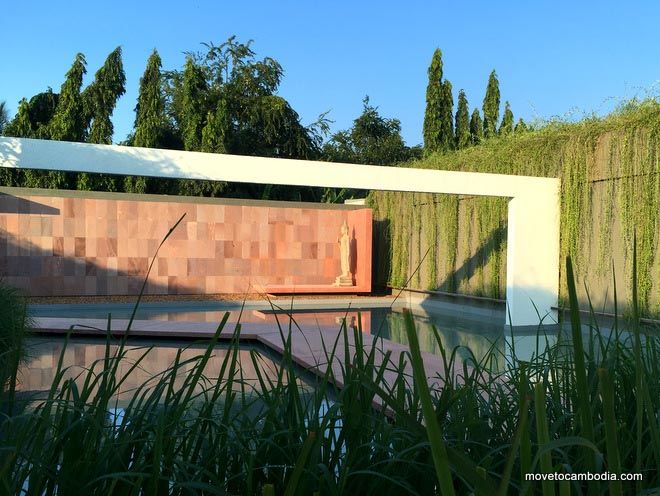
The Balé positions itself as an oasis of calm amid the frenzy of Chroy Changvar development.
And to be fair, that is exactly what it feels like. The hotel complex is low-slung and seems to consist mostly of glass, high-grade pink sandstone, and—perhaps the most precious commodity in tropical Cambodia—green, green grass. A long infinity pool sprawls out along the Mekong, edged by river grasses and palm trees, making it feel almost like you’re swimming in the river (if it cost $200 to swim in a river).
Before coming, we’d read a couple of reviews complaining of noise from an adjacent village. This can be a legitimate problem in Cambodia, where in our city apartment we are usually woken up by various yowls, horns, and crashes before 6 a.m. But we were charmed to realize that The Balé’s “noises” seemed to consist, in total, of the soft warble of traditional Khmer music early in the evening. Later on, it was so quiet we could hear monks chanting from a pagoda down the riverside. We won’t pretend that this is anything approximating actual Cambodian rural life, but it is the most pleasantly sylvan hotel we’ve ever stayed at here.
There are also, of course, disadvantages to being so far up the river. Getting to and from downtown Phnom Penh takes some effort, and would be difficult to do without your own transport, or using one of the hotel’s own cars or tuk-tuks. The hotel offers tour packages for most of the city sites, as well as cycling, golf, and boat excursions. But if you are a do-it-yourself type traveler or relish wandering on your own through city streets, this might not be the best home base. It is definitely a hotel for people who want to spend time in a hotel.
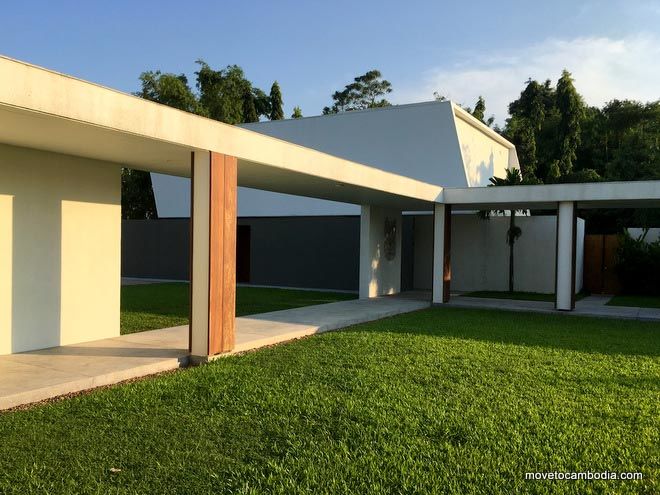
The Balé makes strategic use of breezeways.
Still, tourists tired of the heat and blare of Phnom Penh and yearning for a more bucolic vibe would enjoy a day or two here. It would also be an ideal launching point for a trip to Koh Dach (Silk Island), whose rice fields and pagodas are visible just across the Mekong, or even a stopping point on the way to Siem Reap, if you’re taking a private car.
Unlike most Cambodian hotels, which can be thoughtlessly designed even in their pricier iterations, The Balé’s little touches are generally very thoughtful—light switches and power outlets are where you expect them to be, couches are double-wide, and beds have a wrap-around ledge that serves as a de facto night table. They are also extremely comfortable, although still a hair too short for the taller member of our party (who is, admittedly, very tall).
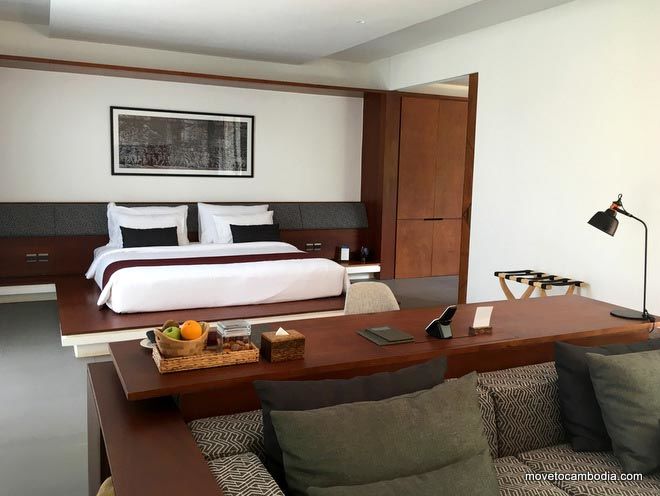
Phnom The Balé is perfect for a Phnom Penh staycation.
We were greeted by a fruit basket, a variety of tiny palm-sugar cookies, and a drawer filled with coffee, tea, and Milo. At most hotels, I cringe when the staff scurry out with a “welcome drink”—almost invariably a cheap, sugary juice designed to give the impression of luxury without any outlay. But The Balé offered up champagne flutes of tangy, just-sweet-enough tamarind juice that were highly drinkable, along with a selection of hor d’oeuvres served on a slate (the lack of plates would become a theme during our stay).
It was initially reassuring to see that The Balé had skirted the most bizarre trend in 21st-century luxury hotel design: the open-plan bathroom. Our “courtyard suite” had a reassuringly hefty door between the bedroom area and the beautifully appointed bathroom, with a rainfall shower, stone bathtub, and Balé-branded jasmine-scented toiletries. Then we noticed that the toilet, tub and shower fronted a curtain-less glass wall that looked out onto the suite’s courtyard, plainly visible from the living room. This wasn’t a problem for us, but I imagine it could create some awkward situations with other configurations of guests.
The in-house restaurant, Theato, is aiming at a Khmer luxe vibe, offering dishes like Mekong lobster kuy teav (noodle soup) and Wagyu beef lot char (fat, grub-like noodles usually found on street corners being fried in hot lard). The food we tried was generally tasty but often perplexingly high-concept. After being served our fourth or fifth dish perched on a wooden board, arranged on a slate, or nestled into a ceramic trough, we were crossing our fingers for an old-fashioned dinner plate.
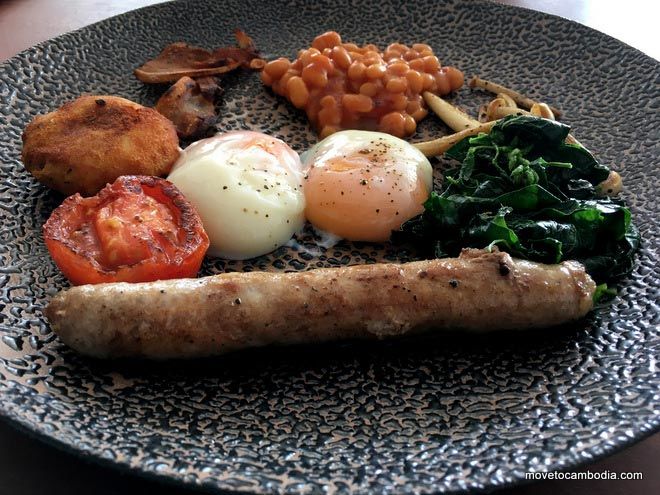
Not quite a plate, but not-not a plate.
Breakfast is included in most room rates and is served menu-style, with guests allowed to choose as many composed plates as they like from a menu of Khmer and Western dishes. The choices included everything from a “farmer’s salad” garnished with a duck egg and tapenade, to three styles of eggs Benedict, to a traditional sausage-laden English breakfast. Croissants and pains au chocolats (on a slate, natch) were flaky and buttery enough that we debated for several minutes whether they might have been baked to order for us. The ricotta pancakes with mango and yogurt ice cream were also delicious, with a little chew that might have come from rice flour, even though the ricotta was inexplicably deconstructed out of the cakes: sprinkled on top rather than, as one might have assumed, incorporated into the batter.
The Balé (which, a manager informed us, means “pavilion” in Balinese and is pronounced “Bah-LAY”) is the first branch of the Singapore-based hotel group “lifestyleretreats” outside of Bali. Staff are kind and hugely enthusiastic about the venture and sign off their emails, “With PassionForLife.” The company touts its newest property as “the ultimate Phnom Penh luxury hotel”—and while that might be a mild over-sell, it does have some unique qualities within the luxury market here. It’s not cheap, but it’s cheaper than other hotels providing a similar level of service and amenities, and offers excellent value for the money. Although we smiled at some touches of pretension, we also had a genuinely lovely stay.
Official rates start at $190 for a courtyard suite and $290 for a riverfront suite, although we found prices as low as $150 on Agoda and Booking.
The Balé
National Road 6a, Bridge No. 8 (around 15 kilometers outside Phnom Penh)
Chroy Changvar peninsula
Tel: +855 (0)23 900 425; 023 900 425
thebalephnompenh.com
→ Check prices and book a room at The Bale on Booking or Agoda now.
We may (or may not) earn commission on sales made through some links on this page. We were given a free stay, although it was not in exchange for a review. We do not give phony reviews in return for freebies. Seriously. For more information about our policies, please see the disclosures section of our About Us page.
Leave a Reply